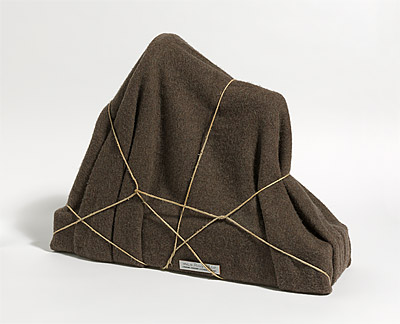MAN RAY
United States of America
1890
–
France
1976
The enigma of Isidore Ducasse
1920 reconstructed 1971
object wrapped in felt and string
no. 8 of an edition of 10
signed and dated, incised on brass plate adhered to felt, "Man Ray 8/10 / The enigma of Isidore Ducasse 1920-1971"
40.5 (h)
x 57.5 (w)
x 21.5 (d)
cm
Purchased 1973
National Gallery of Australia, Canberra
NGA 1973.15
© Man Ray. Licensed by ARS & VISCOPY, Australia
Like most of his objects made up to the late 1940s, May Ray’s sewing machine wrapped in an army blanket and tied with string was originally assembled to provide an unusual subject for a photograph. The inspiration and title derive from a famous line by Lautréamont in Les Chants de Maldoror 1869, evoking ‘the chance meeting on a dissecting-table of a sewing-machine and an umbrella’. The photograph of The enigma of Isidore Ducasse was reproduced in December 1924, in the first issue of the Surrealist periodical La Revolution Surréaliste, and Man Ray later reissued the object in an edition.
May Ray’s photograph in La Revolution Surréaliste was unattributed, uncaptioned and unexplained.[1] Thus, as JH Matthews points out, it acted as a password to the Surrealist initiate, a reference to the enormous impact of the poetry of Isidore Ducasse (1846–1870).[2]Although obviously related, Man Ray’s objects are more fantastic and mysterious than Marcel Duchamp's assisted readymades. Tied with string, this hidden but suggestive shape has a fetishistic, sinister presence. Were the sewing machine (we are told) to be unwrapped, the felt would retain the imprint of the shape within. The enigma of Isidore Ducasse had a profound effect on other Surrealists: Salvador Dali’s essay, ‘The object as revealed in Surrealist experiment’,[3] Man Ray’s bound plaster cast, Vénus restaurée 1936, Hans Bellmer’s bundled dolls, and Duchamp’s Mile of string at First papers of Surrealism in 1942.
Although intentionally discarded after being photographed, The enigma of Isidore Ducasse has had a long life since its first creation in New York in 1920. The versions remade by Man Ray in the 1960s and 1970s―the Canberra example is no 8 from the 1971 edition issued by Galleria Schwarz, Milan, under the artist’s supervision―actually vary a great deal in form. The fabric ‘strait-jacket’ also ranges from felt to a type of hessian or burlap. Much later in life, Man Ray painted La rue Férou 1952, a work which shows a figure pulling a bound object in a handcart along an empty street.[4] Perhaps this painting stands testament to the endurance of Man Ray’s bizarre and intriguing object.
Lucina Ward
Curator
International Painting and Sculpture
National Gallery of Australia, Canberra
[1] Elsewhere, the preface signed by J-A. Boiffard, Paul Ellard and Roger Vitrac, in La Revolution Surréaliste, December 1924, p 2, reads: ‘Any discovery changing the nature, or the destination of an object or phenomenon constitutes a Surrealist achievement. Already the automats are multiplying and dreaming … realism prunes trees, Surrealism prunes life. Quoted in Arturo Schwarz, Man Ray: the rigour of imagination,Thames & Hudson, London, 1977, p 161
[2] JH Matthews, ‘Modes of documentation: photography in La Révolution surréaliste’, in Modern Language Studies, vol 15, no 3, Photography and Literature (Summer, 1985), pp 38–48, at p 39. The poetry of Isidore Ducasse (1846–1870), writing under the penname, Comte de Lautréamont, was much admired by André Breton and the other Surrealists for its strategy of dislocation. In Les chants de Maldoror 1869–70, Ducasse describes a young boy as being as ‘beautiful as the chance meeting on a dissecting table of a sewing-machine and an umbrella’
[3] Published in The Quarter, vol 5 no 1, September 1932; reprinted in Lucy Lippard (ed) Surrealists on art, Prentice-Hall Inc., Englewood Cliffs, New Jersey, 1970, pp 87–96
[4] Oil on canvas, 77.5 x 59.7 cm, Kunsthalle, Bielefeld, on permanent loan from Staff Stiftung, Lemgo.

